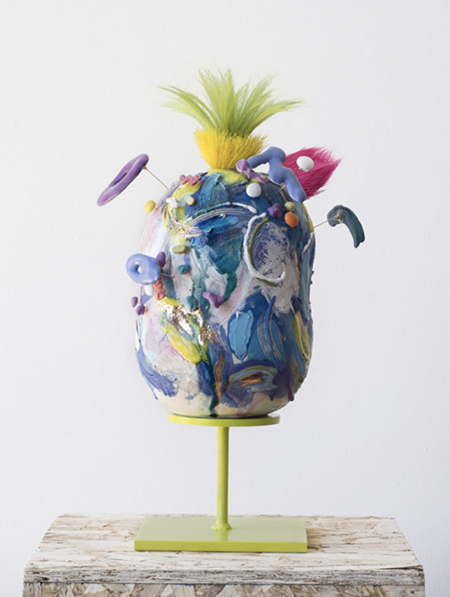
Continuing through April 2, 2022
Much of the reason for ceramic sculpture’s historical regard as a minor art form is its comparatively diminutive size. How, then, to make it bigger and better? For decades mostly California artists (Robert Arneson, Viola Frey, Michael Lucero) addressed the problem of scale by stacking their hand-built forms, some of which towered to 15 feet. Ling Chun handles the issue of scale a bit differently, by adapting the stacking and hand-building parts to pedestal-size sculptures, brightly colored, vaguely figurative, and dripping with add-ons. Those add-ons are the other key to how ceramic sculptors made their way into art galleries: they added other materials, anything but more clay. This lifted them out of the clay figurine category or much-feared knickknack ghetto, and onto the hallowed modernist plane of assemblage.
A graduate of the School of the Art Institute of Chicago and Rhode Island School of Design, Chun readily adapted her polyglot Hong Kong heritage — Chinese, British, et al. — to a contemporary American vocabulary of surrealist imagery and Pop art material overkill. Poor taste, as in kitsch, rather than good taste, as in faux-Japanese folk pottery, is celebrated with neon as her opening salvo. She has become more American than Minnesota or Montana, citadels of wood-fired slabs. Tacky is celebrated, and taste might only refer to street food, Lunar New Year banners and flags, and dwindling or decaying recycled materials and throwaways; but not aesthetics.
Back-lit in different colors of neon, the “Sigh/Sign” series (“Blue,” “Green,” “Red,” and “Purple”) is mounted on a see-through folding screen of flimsy wooden pallets. The neon creates a nighttime aura surrounding each two-by-two or three-by-three grid of circular, stacked blobs of colored and glazed clay. The spatters could be abstracted Chinese ideograms, flying off the inert surfaces.
Elsewhere, sculptural shapes vary from conventional, but gesturally “attacked,” ginger jars on a shelf (“High and Low Dark, Pink, Blue and Green”), through wall-mounted diamond-shields made of bulging inverted rice bowls (“Apparatus of Home”), and a forward tilted, flat 16-tile grid (“Apparatus of Missing Moon”). In the latter, an inner disc-shape with battered blue-and-white shards alludes to the exhibit title, a comment on lunar eclipses as well as the artist’s nostalgia for her birthplace. Safe in the US, she is “looking for the moon in Hong Kong but staring at the bright sky of the States where all I find is my missing moon.” These works dismantle or reverse traditional clay construction steps, rendering a conceptual dimension, i.e., seeing the disc shatter and re-conform to a circular shape rather than watching it emerge on a pottery wheel. While the moon is a cardinal literary motif in Chinese poetry and painting, it is also the key to agricultural wisdom and other homely celebrations, usually revolving around food.
Echoing big-name ceramic artists Edmund de Waal and Charles LeDray and glass artist Josiah McElhenny, Chun sets nine three-inch-high blue pots on a shelf next to one another. Yes, “Blue Willow” ware collectors will clue in on their oblique familiarity, but others can just as easily imagine phases of the moon, sometimes visible, sometimes missing. Chun’s power as a symbolist may have Chinese cultural origins, but her Hong Kong ties and US residence forever opened her creative horizons.
“Missing Moon” is a smaller grouping than most of her shows, but a good backgrounder on where she is headed. The slightly strained wooden rack folding screen and the derivative multi-piece shelf displays are not Chun at her best. The single assemblage sculptures are convincing, and hopefully Chung will find ways to increase their scale. “Pine-Apple” (2018) daubs on fur and hair with metal appurtenances, dressing up the traditional symbol of hospitality of 18th century America (and British colonies like Hong Kong) and adding a suspicious, jagged edge. “Lanterier” (2018) is the most figurative here, an assaulted male figure with bloody, lopped-off arms that stretch out in gruesome welcome. It would be worth it to see Chun combine her helplessly glamorous, Hong Kong exuberance with references (like this one) to mainland horror and injustice. That way, she could leave waning nostalgia for Hong Kong behind and rejoin the world at large. The spring equinox moon is now, today. It is not missing.
